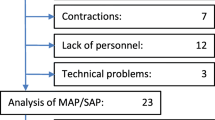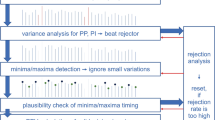Abstract
Physicians often need to measure arterial PCO2 in clinical practice. Arterial blood gas sampling is typically available only in hospitals and may be unpleasant for patients. Minimally invasive techniques for measuring PCO2 offer the potential for overcoming these limitations. The MicroStat monitor non-invasively measures PCO2 in the sublingual tissues, which should track arterial PCO2 in hemodynamically stable patients. This was a prospective observational study. Patients undergoing routine cardiac catheterization were recruited. Following arterial cannulation, two sequential sublingual PCO2 measurements were taken and a contemporaneous arterial sample was sent for blood gas analysis. For each subject we calculated the mean sublingual–arterial CO2 gradient and the test–retest sublingual PCO2 difference. Twenty-five patients were studied. Mean sublingual–arterial PCO2 gradient was +6.8 mmHg (95 % limits of agreement −3.0 to 16.6 mmHg). Test–retest difference was 3.4 mmHg (95 % limits of agreement −1.1 to 7.9 mmHg), p = 0.11 (Wilcoxon test), repeatability was 11 mmHg. The MicroStat sublingual PCO2 monitor over-estimates arterial PCO2 with wide limits of agreement. Test–retest repeatability was poor. Use of sublingual PCO2 monitoring with the MicroStat monitor cannot currently replace blood gas sampling.


Similar content being viewed by others
Abbreviations
- CO2 :
-
Carbon dioxide
- PslCO2 :
-
Partial pressure of CO2 in sublingual region
- PaCO2 :
-
Partial pressure of CO2 in arterial blood
- PCO2 :
-
Partial pressure of CO2
References
Lim BL, Kelly AM. A meta-analysis on the utility of peripheral venous blood gas analyses in exacerbations of chronic obstructive pulmonary disease in the emergency department. Eur J Emerg Med. 2010;17:246–8.
Zavorsky GM, Cao J, Mayo NE, Gabbay R, Murias JM. Arterial versus capillary blood gases: a meta-analysis. Respir Physiol Neurobiol. 2007;155:268–79.
Baron BJ, Dutton RP, Zehtabchi S, Spanfelner J, Stavile KL, Khodorkovsky B, Nagdev A, Hahn B, Scalea TM. Sublingual capnometry for rapid determination of the severity of hemorrhagic shock. J Trauma. 2007;62:120–4.
Marik PE. Sublingual capnography: a clinical validation study. Chest. 2001;120:923–7.
Rackow EC, O’Neil P, Astiz ME, Carpati CM. Sublingual capnometry and indexes of tissue perfusion in patients with circulatory failure. Chest. 2001;120:1633–8.
Bland JM, Altman DG. Statistical methods for assessing agreement between two methods of clinical measurement. Lancet. 1986;327:307–10.
Bland JM, Altman DG. Statistics notes: measurement error. BMJ. 1996;313:744.
ABL700 series reference manual. Accessed at http://www.radiometeramerica.com/~/media/files/radiometercomcloneset/rame/manuals/abl700/989-311w-abl700-operators-manual—english.pdf.
Acknowledgments
We wish to thank Faye Blenkhorn RN and the nursing staff of the catheterization laboratory for their support during the conduct of the study.
Conflict of interest
This study was investigator initiated. ExoStat Medical Inc provided the following at zero cost: MicroStat device and sufficient sensors to complete the study and training on the system. No incentives, financial or otherwise were offered to the investigators by ExoStat Medical. The data acquisition, analysis, interpretation and publication are the sole responsibility of the investigators. None of the authors have a Competing Interest to report with the content of this manuscript.
Ethical standard
All procedures performed in studies involving human participants were in accordance with the ethical standards of the institutional Research Ethics Committee and with the 1964 Helsinki declaration and its later amendments or comparable ethical standards.
Informed consent
Informed consent was obtained from all individual participants included in the study.
Author information
Authors and Affiliations
Corresponding author
Rights and permissions
About this article
Cite this article
Fox, B.D., Joyal, D., Schlesinger, R.D. et al. Evaluation of the Microstat™ sublingual PCO2 monitor in ambulatory patients. J Clin Monit Comput 30, 77–80 (2016). https://doi.org/10.1007/s10877-015-9686-7
Received:
Accepted:
Published:
Issue Date:
DOI: https://doi.org/10.1007/s10877-015-9686-7




